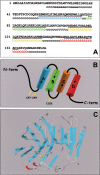Role of the soluble pattern recognition receptor PTX3 in vascular biology
- PMID: 17760835
- PMCID: PMC3823252
- DOI: 10.1111/j.1582-4934.2007.00061.x
Role of the soluble pattern recognition receptor PTX3 in vascular biology
Abstract
Pentraxins act as soluble pattern recognition receptors with a wide range of functions in various pathophysiological conditions. The long-pentraxin PTX3 shares the C-terminal pentraxin-domain with short-pentraxins C-reactive protein and serum amyloid P component and possesses an unique N-terminal domain. These structural features suggest that PTX3 may have both overlapping and distinct biological/ligand recognition properties when compared to short-pentraxins. PTX3 serves as a mechanism of amplification of inflammation and innate immunity. Indeed, vessel wall elements produce high amounts of PTX3 during inflammation and the levels of circulating PTX3 increase in several pathological conditions affecting the cardiovascular system. PTX3 exists as a free or extracellular matrix-associated molecule and it binds the complement fraction C1q. PTX3 binds also apoptotic cells and selected pathogens, playing a role in innate immunity processes. In endothelial cells and macrophages, PTX3 upregulates tissue factor expression, suggesting its action as a regulator of endothelium during thrombogenesis and ischaemic vascular disease. Finally, PTX3 binds the angiogenic fibroblast growth factor-2, thus inhibiting its biological activity. Taken together, these properties point to a role for PTX3 during vascular damage, angiogenesis, atherosclerosis, and restenosis.
Figures



References
-
- Garlanda C, Bottazzi B, Bastone A, Mantovani A. Pentraxins at the crossroads between innate immunity, inflammation, matrix deposition, and female fertility. Annu Rev Immunol. 2005;23:337–66. - PubMed
-
- Goodman AR, Cardozo T, Abagyan R, Altmeyer A, Wisniewski HG, Vilcek J. Long pentraxins: an emerging group of proteins with diverse functions. Cytokine Growth Factor Rev. 1996;7:191–202. - PubMed
-
- Steel DM, Whitehead AS. The major acute phase reactants: C-reactive protein, serum amyloid P component and serum amyloid A protein. Immunol Today. 1994;15:81–8. - PubMed
-
- Pepys MB, Baltz ML. Acute phase proteins with special reference to C-reactive protein and related proteins (pentaxins) and serum amyloid A protein. Adv Immunol. 1983;34:141–212. - PubMed
-
- Du Clos TW. The interaction of C-reactive protein and serum amyloid P component with nuclear antigens. Mol Biol Rep. 1996;23:253–60. - PubMed
Publication types
MeSH terms
Substances
LinkOut - more resources
Full Text Sources
Research Materials
Miscellaneous

